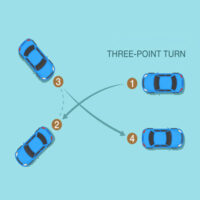When You Can And Can’t Make A Three-Point Turn

A three-point turn is a driving maneuver that allows you to reverse direction. It is a popular turn when a road is too narrow to complete a U-turn effectively. While it may seem straightforward, executing a three-point turn in the wrong situation can lead to traffic violations and, more critically, collisions that result in serious injuries.
Knowing when it’s legal to perform a three-point turn, and when it isn’t, can help you avoid accidents and the potential legal consequences that come with them. If a collision does occur, an Orlando personal injury attorney can help you navigate the legal aftermath and fight for the compensation you need to recover.
Understanding Three-Point Turns and Their Legality
A method used by drivers to turn around on a road when space is limited, a three-point turn involves three steps. First, you need to turn the vehicle to the left (or right, depending on the direction you wish to go) until you are perpendicular to the road. Next, you reverse the vehicle in the opposite direction, so it’s facing the other side of the road. Finally, you drive forward into the desired direction of travel.
In Florida, as in many other states, a three-point turn is generally legal when performed safely and without violating traffic laws. That said, you need to perform all turns when there is clear visibility. This means you should not attempt a three-point turn on a curve, near a hill, or in any situation where you cannot see far enough ahead to ensure safety.
Also, ideally a three-point turn should be performed on a road with low traffic volume. Attempting this maneuver on a busy street or highway is not only dangerous but also illegal. And of course, if there are signs indicating that U-turns or turns of any kind are prohibited, you cannot legally perform a three-point turn. This includes areas near intersections, school zones, or any other location where turning around would disrupt traffic flow.
How Three-Point Turns Can Lead to Collisions
Executing a three-point turn in an unsafe location can easily result in a collision. The maneuver involves crossing over lanes of traffic and can take longer to complete than a standard turn, increasing the likelihood that another vehicle might not see you in time to stop.
After sustaining an injury in a collision involving a three-point turn, whether you were the one making the turn or were struck by someone attempting it, connect with an Orlando personal injury attorney. A lawyer can assess the details of your case, gather evidence to prove liability, and work to secure compensation for your medical expenses, lost wages, and pain and suffering. With a skilled lawyer on your side, you can ensure your rights are protected and that you receive the compensation you deserve.
Did an unexpected turn lead to your accident injury? Have a conversation with the experienced car accident attorneys at Israoui Law. Always speak to an experienced injury attorney before speaking to any insurance company. There is support available as you recover and move forward. For the personal attention you deserve, call 407-381-4529.

